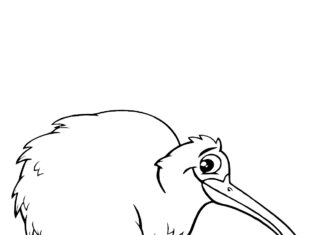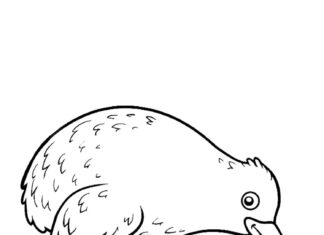Of course, I'm happy to provide information about kiwifruit! Kiwi is a fruit that originated mainly in China, although it is now grown all over the world. It is known for its distinctive taste, richness in vitamins and nutrients.
Kiwi Coloring Pages
information
- Origins and history: The kiwi (Actinidia deliciosa) originally came from China, where it was known as "yang tao." The name "kiwi" was given to it in New Zealand in honor of a small bird with a similar appearance, which is a symbol of that country. The name has since been adopted worldwide.
- Appearance and taste: Kiwifruit has brown, hairy skin and light green flesh with distinctive black seeds. Its flavor is sweet and sour and intense. There are also commercially available varieties with different colored flesh, such as golden kiwifruit (with yellow flesh) and green kiwifruit (with green flesh).
- Nutritional value: Kiwi is a rich source of vitamin C, vitamin K, vitamin E, vitamin A, folic acid and potassium. It also contains fiber, which is beneficial to the digestive system. The seeds inside the kiwi provide an extra dose of nutrients.
- Health Benefits: Due to its abundance of vitamin C, kiwifruit supports the immune system, helps protect against free radicals, and benefits skin condition. In addition, the enzymes in kiwifruit, such as actinidin, can help digest proteins.
- Cultivation: Kiwi is planted on vines and needs a warm climate to grow. It requires well-draining soil and enough sun. It is also common to grow kiwifruit on pergolas or supports.
- Application: Kiwi can be eaten on its own as a fresh fruit, added to salads, smoothies, desserts or yogurts. It is also a popular ingredient in juices and fruit preserves.
-
Varieties: In addition to the classic green kiwi, there are other varieties, such as:
- Golden kiwifruit (Actinidia chinensis): It has a smooth skin and bright yellow flesh. It is sweeter and less acidic than the green kiwi.
- Marbled kiwifruit (Actinidia melanandra): It is characterized by reddish-purple skin and light green flesh.
trivia
- The name comes from the bird: The name "kiwi" was given to this fruit in honor of the small bird of the same name, which is the symbol of New Zealand. This bird is flightless and has a distinctive appearance.
- Source of vitamin C: Kiwifruit is one of the richest sources of vitamin C among fruits. In fact, consuming one kiwi can provide significantly more vitamin C than a typical serving of oranges.
- Actinidin enzyme: Kiwi contains an enzyme called actinidin, which is known for its digestive properties. Therefore, kiwi can help digest proteins, which can be especially beneficial for people with sensitive stomachs.
- Golden kiwis: Along with the popularity of the green kiwi, there was also a variety with yellow flesh, called "golden kiwi" or "Chinese kiwi." It is sweeter than the classic kiwi and has a smooth skin.
- New Zealand History: Green kiwifruit is also known as "Hayward kiwifruit" - named after Hayward Wright, the New Zealander who first began commercial cultivation of the fruit in New Zealand.
- Symbol of maturity: Checking the ripeness of the kiwi can be done by gently pressing your finger on the skin. If it is soft, the fruit is probably ready to eat.
- Kiwi seeds: The seeds inside the kiwi are edible and provide an extra dose of fiber and other nutrients. Some people pick them out of the flesh and eat them separately.
- Marbled fruit: The marbled kiwi variety is characterized by reddish-purple skin and multicolored flesh. It is an interesting alternative to traditional varieties.
- Kiwi as soft meat: Kiwi contains proteolytic enzymes, including actinidin, which can break down proteins. Therefore, adding kiwi to meat dishes can make the meat softer.
- Cosmetic products: Due to its high content of vitamin C and other skin-beneficial ingredients, kiwi extracts are often used in skin care products and cosmetics.
- Similarity to gooseberries: Early kiwifruit may have some similarity in taste to gooseberries, as they are more sour. Mature varieties tend to be sweeter.










